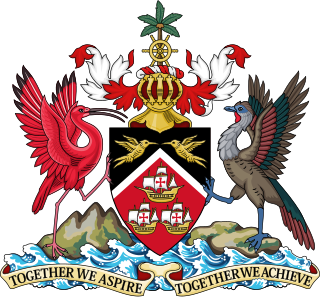The history of Trinidad and Tobago begins with the settlements of the islands by Indigenous First Peoples. Trinidad was visited by Christopher Columbus on his third voyage in 1498,, and claimed in the name of Spain. Trinidad was administered by Spanish hands until 1797, but it was largely settled by French colonists. Tobago changed hands between the British, French, Dutch, and Courlanders, but eventually ended up in British hands following the second Treaty of Paris (1814). In 1889, the two islands were incorporated into a single political entity. Trinidad and Tobago obtained its independence from the British Empire in 1962 and became a republic in 1976.

The On-to-Ottawa Trek was a mass protest movement in Canada in 1935 sparked by unrest among unemployed single men in federal relief camps principally in Western Canada. The trek started in Vancouver and, picking up reinforcements along the way, was conducted by riding traincars eastward. The trek was stopped in Regina where on July 1, 1935 police dispersed it with loss of life and mass arrests.
Red Clydeside was the era of political radicalism in Glasgow, Scotland, and areas around the city, on the banks of the River Clyde, such as Clydebank, Greenock, Dumbarton and Paisley, from the 1910s until the early 1930s. Red Clydeside is a significant part of the history of the labour movement in Britain as a whole, and Scotland in particular.
The Australian labour movement began in the early 19th century and since the late 19th century has included industrial and political wings. Trade unions in Australia may be organised on the basis of craft unionism, general unionism, or industrial unionism. Almost all unions in Australia are affiliated with the Australian Council of Trade Unions (ACTU), many of which have undergone a significant process of amalgamations, especially in the late 1980s and early 1990s. The leadership and membership of unions hold and have at other times held a wide range of political views, including socialist, democratic and right-wing views.

The Democratic Labour Party was the main opposition party in Trinidad and Tobago from 1957 till 1976. That party was the party which opposed the People's National Movement (PNM) at the time of Independence. After several splits brought about by leadership struggles, the party lost its hold on the Indo-Trinidadian community in the 1976 General Elections and was displaced in parliament by the United Labour Front under the leadership of Basdeo Panday, a former DLP senator. The party was the representative of the ethnic Indian community in the country; however Indian Muslims and Christians were said to be less loyal to the party than Indian Hindus.
The culture of Trinidad and Tobago reflects the influence of Indian-South Asian, African, Indigenous, European, Chinese, North American, Latino, and Arab cultures. The histories of Trinidad and Tobago are different. There are differences in the cultural influences which have shaped each island. Trinidad and Tobago is an English-speaking country with strong links to the United Kingdom.

The Hock Lee bus riots took place on 12 May 1955 in Singapore. The riots started as a result of confrontation between the police, bus workers of the Hock Lee Amalgamated Bus Company and students who supported the bus workers.
The Black Power Revolution, also known as the Black Power Movement, 1970 Revolution, Black Power Uprising and February Revolution, was an attempt by a number of social elements, people and interest groups in Trinidad and Tobago to subvert the neocolonial order held over from the days of British slavery and imperialism, and supported by Anglo-American collusive efforts to maintain dominating influence in the Caribbean region.
The National Union of Freedom Fighters (NUFF) was an armed Marxist revolutionary group in Trinidad and Tobago. Active in the aftermath of the 1970 Black Power Revolution, the group fought a guerrilla warfare campaign to overthrow the government of Prime Minister Eric Williams following the failed Black Power uprising and an unsuccessful mutiny in the Trinidad and Tobago Regiment.

The protests of 1968 comprised a worldwide escalation of social conflicts, which were predominantly characterized by the rise of left-wing politics, anti-war sentiment, civil rights urgency, youth counterculture within the silent and baby boomer generations, and popular rebellions against state militaries and bureaucracies.

The Italian Syndicalist Union is an Italian anarcho-syndicalist trade union. Established in 1912 by a confederation of "houses of labour", the USI led a series of general strikes throughout its early years, culminating with the Red Week insurrection against the Italian entry into World War I. During the Biennio Rosso, the USI was at the forefront of the occupation of factories, which saw hundreds of workplaces throughout the country brought under the control of workers' councils. The USI also led the establishment of the International Workers' Association (IWA), which became the main international organisation of anarcho-syndicalist trade unions.

Hosay is a Muslim Indo-Caribbean commemoration that is popularly observed in Trinidad and Tobago, Jamaica and other Caribbean countries. In Trinidad and Tobago, multi-coloured model mausoleums or mosque-shaped model tombs known as tadjah are used to display the symbolic part of this commemoration. They are built and paraded, then ritually taken to the sea on last day of observance, and finally discarded into the water. The word tadjah derived from the Arabic word ta'zieh and signifies different cultural meanings depending on the region, time period, occasion, and religion. In Guyana, and Suriname, the festival is called Taziya or in Caribbean Hindustani tadjah in reference to these floats, arguably the most visible and decorative element of this festival.
The Hosay massacre took place on 30 October 1884 in San Fernando, Trinidad when the British colonial authorities fired on participants in the annual Hosay procession who had been banned from entering the town.
A series of workplace disturbances, strikes, and riots broke out across the British West Indies in the period between 1934 and 1939. These began as the Great Depression wore on and ceased on the eve of World War II. The unrest served to highlight inequalities of wealth, led the British government to attempt a solution to the problem, and in some cases spurred the development of indigenous party politics that would lead to self-government and independence in the postwar period.

The 1969 Curaçao uprising was a series of riots on the Caribbean island of Curaçao, then part of the Netherlands Antilles, a semi-independent country in the Kingdom of the Netherlands. The uprising took place mainly on 30 May but continued into the night of 31 May – 1 June 1969. The riots arose from a strike by workers in the oil industry. A protest rally during the strike turned violent, leading to widespread looting and destruction of buildings and vehicles in the central business district of Curaçao's capital, Willemstad.
The 1980 Upper Voltan coup d'état took place on 25 November 1980 in the Republic of Upper Volta. Following a long period of drought, famine, popular unrest and labour strikes, Colonel Saye Zerbo overthrew President Sangoulé Lamizana, another military leader. Zerbo himself would be overthrown only two years later.
The labour movement is the collective organisation of working people to further their shared political and economic interests. It consists of the trade union or labour union movement, as well as political parties of labour. It can be considered an instance of class conflict.
The Black Power Movement in Montreal in the 1960s was a period of rediscovering black identity through a process of invoking cultural, economic, and political thought amongst blacks. The eruption of political activism during Montreal's Quiet Revolution as well as the reformation of immigration policies which discriminated against non-white immigrants allowed black communities to publicly express and bring awareness to their struggles with racism. The movement was an integral component of the emerging global challenges to imperialism during the 1960s, stemming from various movements including Garveyism, pan-Africanism, the Harlem Renaissance, Rastafari, and others. Montreal's Black Power movement culminated in the aftermath of the Sir George Williams Affair—a student occupation that resulted in an estimated $2 million worth of damages and 97 arrests—which raised concerns of racism worldwide.






